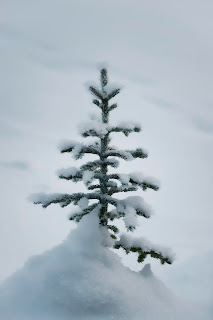 Week 30
Week 30I have been looking for a good minimalist image for sometime now. It seems like it would be easy, but this is the first one I thought might be good enough to publish here.
The idea is to get rid of the clutter. Only retain what is necessary. Reduce shapes and color to a minimum and leave some space. No need for fancy lighting here.
This tree was poking out of about a meter or more of snow on the shoreline of Lake Louise. The lake is in the background, frozen over, and covered with snow. The texture in the background are old footprints from someone crossing the lake.
Technically taking the picture is easy. I'll give you the settings but it is seeing the picture that I find hard.
The camera is a Nikon D3 with an AF-S Nikkor 24-70mm 1:2.8G ED lens. The camera is in aperture preferred mode, auto focusing, and set at ISO 200. The lens is at f/2.8 to minimize depth of field and the camera chose 1/1000 of a second. I checked the histogram and had plenty of room top and bottom because of the cloudy conditions. Look at the very soft shadows and you'll see that the sun is behind the tree and a bit to the right.
Post consisted of a bit of color balancing to get rid of some but not all the blue cast and an exposure adjustment in camera raw. I smoothed the snow a bit with a blur in the background in Photoshop but left shading and the diagonal footprints.
Idea from Keep it Simple Stupid, pages 60-61 in the book 50 Photo Projects by Lee Frost.

